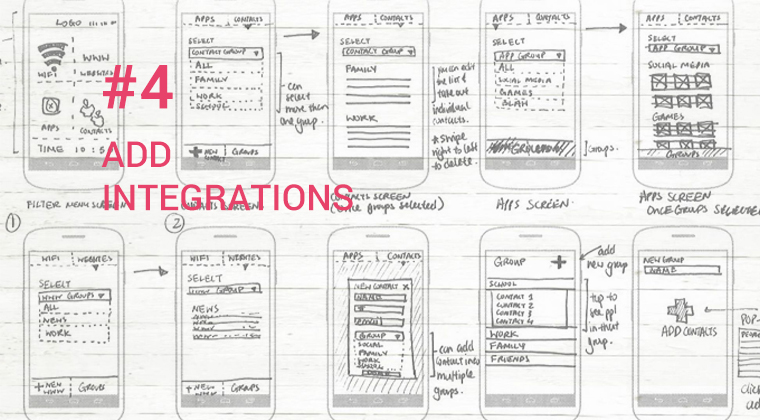
How many apps do you have installed? How many of them do you actually use? According to Statista, the number of apps on AppStore has changed from 1.5 to 2 million. For Google Play, this change was from 1.8 to 2.2 million applications available. As it turns evident, the mobile app market is dynamic and develops fast. And it is definitely full of trash.
Obviously, mobile apps quantity does not mean their quality. As we’ve mentioned in our previous post, customers refer to mobile apps installed on their smartphones for only 8 seconds on average. So, downloading the app and using it are not the same things.
How does it happen that mobile application does not work as you expected – too slow, too complicated, too outdated? We think you can answer these questions by looking at this checklist of the key steps that prevent mobile app failure.
№1 Learn your audience and market

Considering a great number of mobile apps in the market, there’s no surprise there’re a lot of trashy apps. As SAP reports, the first interaction with mobile app is the last one at the same time in 78% occasions. Why does it happen?
Commonly, developers understand customers’ needs adequately and do not create any problem-solving mobile app for them (even if they think they do). Thus, each solution should address a particular market need, which is carefully investigated before launching the development process.
Such research means that your mobile app idea should clearly define some specific audience, consider level of competition with other apps, provide solution for core problem, and offer strategies for further development. Without this step, you cannot know for sure whether customers really need your solution. In our previous blog post, we’ve discussed MVP development along with market research and win-loss analysis as methods that help you connect your idea with your target customers.
Regardless the method, consider analysis as the first step and an inevitable element of your mobile app development at any stage.
№2 Change the approach
One of the biggest problem in mobile app development is that it is hard to adjust its web version to the smartphone screen. Nevertheless, it is necessary to meet this difference.
You should consider the following factors that differ mobile version from web version: the screen size, limited functionality, and personalization that differs it from the web version. People use their phones for numerous tasks at once and expect applications installed on them to cover all their needs. This is the key challenge for mobile app developers.
To avoid their mistake, consider mobile app as entirely new task that requires specific approach. Navigation tops the list, because you have only 8 seconds to engage your customer. Do you want them to maze or see the exact reason why they need your app? Choosing the approach means answering this question.
№3 Make the first step

Would you like to join those 78% of apps that failed? Perhaps, no. The same as you’re looking to get negative reviews just after launching the app.
To avoid all these problems, pay ample attention to creating a prototype. This instrument is highly useful for understanding the functionality and see the necessary changes on the earliest stage of mobile app development. In particular, prototyping helps to make sure that users will feel okay with the app’s UX and won’t quit too early.
In our blog, there’s an article on prototyping as the necessary beginning of any development process with useful examples of exact tools to prototype development.
№4 Extend your app’s functionality

Would you like to make your users’ experience more favourable and convenient? Provide them with social networks integrations! This way you’ll definitely save them some time of switching between the apps and waiting while some app loads.
Even though developing APIs appears as a time-consuming measure, they make users feel more convenient and ensure business logic of your mobile app. Among all, consider the simplicity of data obtaining and maintenance through APIs.
It doesn’t matter if the mobile app API relates to your website or is operated by a 3rd party system, pay great attention to the data processing speed.To achieve satisfactory results, remember that the less information you mobile app receives, the faster it processes data.
While considered carefully, APIs can even generate revenues for you in the forms of pay-for-use, subscription, and resource-usage model. With all these advantages, APIs worth dedicating so much time to them.
№5 Keep UI/UX in mind

Besides changing the approach from web to mobile app, the choice of platform is also critical. Since Android and iOS have different features in terms of interface and discoverability, you should not neglect them.You can build an awesome app for Android, but if you don’t adapt the interface to iOS – that’s a fail. Users will quit in that critical 8 seconds.
To have them engaged, mobile app developers should dedicate significant attention to platform-specific UI/UX, meaning working on attractive design in terms of user interface and user experience. In fact, your customers will remember their feelings of the way you provide the information, than on its sense. Because of this, you should meet the current UI/UX requirements by creating the most appealing combination of text, graphics, background, and interactive elements.
Among the concrete tools, light design, limited number of fonts and colors, and grouping the content to emphasize on the most important data can help you succeed in attracting users. By addressing other current trends in UI/UX, you can create the most appealing design for your customers. For example, 3D touch is an important element you should take into consideration while developing your mobile app for iPhone 6 and 6s. To investigate closely the role of both UI and UX for your business, refer to this post in our blog.
№6 Let users know about your app

Despite your business activity type, marketing is always important. In case of mobile apps, your primary task is to demonstrate users its core functionality and show HOW your app will solve their problem. Customers should know what to expect from your app before they actually start interacting with it.
You can find several articles that list marketing websites for mobile apps. They offer a number of options to promote your app, including Facebook Ads, blogging, applying for app rewards etc. As for NexGenDesign experience, we recommend mobile app’s integration and simplicity as underlying principles of your PR campaign. You can feature the app on your website and social networks (pay specific attention to Facebook, Google+, and Linkedin) and create some promotional materials (videos and images) to share via your network. Also, mobile app can sell itself if you design minimalistic icon and interesting screenshots that attract users.
By working on marketing, stress on the core solution your app offers to attract your target customers!
№7 Limit the functions
In the previous sections, we’ve already mentioned that mobile app requires completely different approach in contrast to web version in terms of simplicity and limitations. Thus, reducing the number of functions is the key requirement for your mobile app to work and interact with users. As it is evident from the title, mobility is the key feature of any mobile app.
By meaning accordance to customers’ expectations and ensuring firms’ profitability, mobile simplicity is the guarantee that users will have great experience with your app. Because of this, APIs and simple UI/UX design create complex structure of your app that contributes to the appropriate solving of the primary customer need. In other words, creating a set of basic functions refers to a better usability that encourages customers to use your mobile app again.
№8 Earn with your app

As a final step, monetization is the key indicator of mobile app success. As you can notice in both AppStore and Google Play, mobile apps are mostly free. In this situation, it is important to consider the strategy of obtaining money for your app after your customers upload and start interacting with it regularly.
Try to offer your clients extra content, bonuses or make specific features available only after payment: game currency, extra health/characters, removing ads, subscriptions etc. Based on your aim, you can choose among different monetization tools: advertising, newsletters and SMS, partnerships, in-app purchases and so on. Besides, the concrete choice among these instruments also depends on available data (meaning mobile phones and e-mails) and the app appearance you’ve created (whether basic and premium accounts are possible).
At the same time, feel free not to limit yourself to only one monetization tactic. The key limitation you consider is that your mobile application should remain integrated and simple. With too many monetization features in one app, you can destroy the best UI/UX design and overload with integrations. Therefore, don’t go crazy about making money of your app but choose a couple of approaches that will work in your specific case.
Are you ready to succeed?
As you see, you should take into account numerous aspects of mobile app development not to fail. If you still feel unconfident or have any trouble with hiring a matching team, we are always ready to assist you!
Any mobile app wouldn’t fail if only its developers have carefully met all the requirements mentioned here. Be sure to succeed by avoiding typical mistakes others have done!





